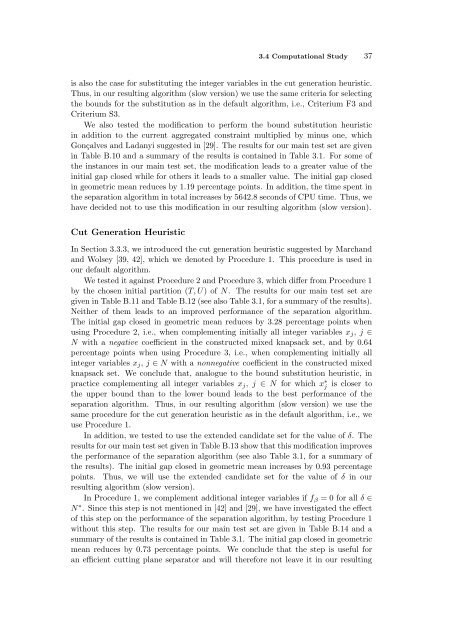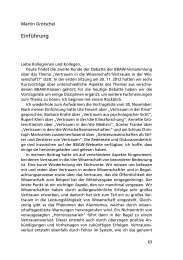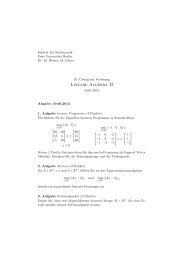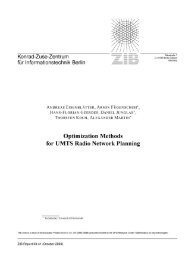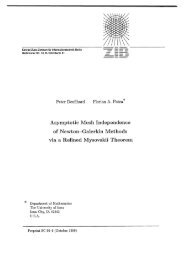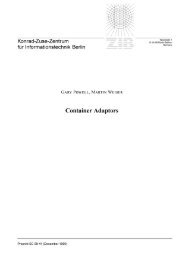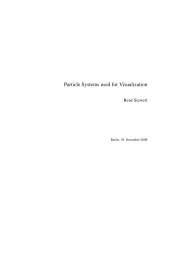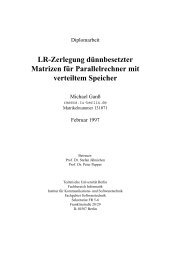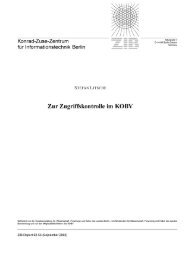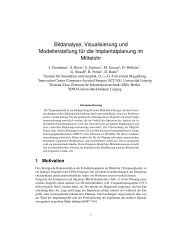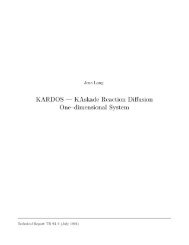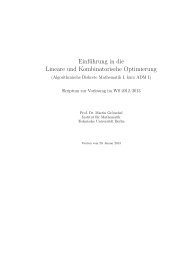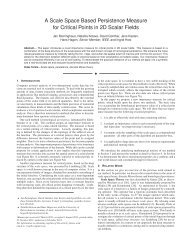Implementation of Cutting Plane Separators for Mixed Integer ... - ZIB
Implementation of Cutting Plane Separators for Mixed Integer ... - ZIB
Implementation of Cutting Plane Separators for Mixed Integer ... - ZIB
Create successful ePaper yourself
Turn your PDF publications into a flip-book with our unique Google optimized e-Paper software.
3.4 Computational Study 37<br />
is also the case <strong>for</strong> substituting the integer variables in the cut generation heuristic.<br />
Thus, in our resulting algorithm (slow version) we use the same criteria <strong>for</strong> selecting<br />
the bounds <strong>for</strong> the substitution as in the default algorithm, i.e., Criterium F3 and<br />
Criterium S3.<br />
We also tested the modification to per<strong>for</strong>m the bound substitution heuristic<br />
in addition to the current aggregated constraint multiplied by minus one, which<br />
Gonçalves and Ladanyi suggested in [29]. The results <strong>for</strong> our main test set are given<br />
in Table B.10 and a summary <strong>of</strong> the results is contained in Table 3.1. For some <strong>of</strong><br />
the instances in our main test set, the modification leads to a greater value <strong>of</strong> the<br />
initial gap closed while <strong>for</strong> others it leads to a smaller value. The initial gap closed<br />
in geometric mean reduces by 1.19 percentage points. In addition, the time spent in<br />
the separation algorithm in total increases by 5642.8 seconds <strong>of</strong> CPU time. Thus, we<br />
have decided not to use this modification in our resulting algorithm (slow version).<br />
Cut Generation Heuristic<br />
In Section 3.3.3, we introduced the cut generation heuristic suggested by Marchand<br />
and Wolsey [39, 42], which we denoted by Procedure 1. This procedure is used in<br />
our default algorithm.<br />
We tested it against Procedure 2 and Procedure 3, which differ from Procedure 1<br />
by the chosen initial partition (T, U) <strong>of</strong> N. The results <strong>for</strong> our main test set are<br />
given in Table B.11 and Table B.12 (see also Table 3.1, <strong>for</strong> a summary <strong>of</strong> the results).<br />
Neither <strong>of</strong> them leads to an improved per<strong>for</strong>mance <strong>of</strong> the separation algorithm.<br />
The initial gap closed in geometric mean reduces by 3.28 percentage points when<br />
using Procedure 2, i.e., when complementing initially all integer variables xj, j ∈<br />
N with a negative coefficient in the constructed mixed knapsack set, and by 0.64<br />
percentage points when using Procedure 3, i.e., when complementing initially all<br />
integer variables xj, j ∈ N with a nonnegative coefficient in the constructed mixed<br />
knapsack set. We conclude that, analogue to the bound substitution heuristic, in<br />
practice complementing all integer variables xj, j ∈ N <strong>for</strong> which x ∗ j<br />
is closer to<br />
the upper bound than to the lower bound leads to the best per<strong>for</strong>mance <strong>of</strong> the<br />
separation algorithm. Thus, in our resulting algorithm (slow version) we use the<br />
same procedure <strong>for</strong> the cut generation heuristic as in the default algorithm, i.e., we<br />
use Procedure 1.<br />
In addition, we tested to use the extended candidate set <strong>for</strong> the value <strong>of</strong> δ. The<br />
results <strong>for</strong> our main test set given in Table B.13 show that this modification improves<br />
the per<strong>for</strong>mance <strong>of</strong> the separation algorithm (see also Table 3.1, <strong>for</strong> a summary <strong>of</strong><br />
the results). The initial gap closed in geometric mean increases by 0.93 percentage<br />
points. Thus, we will use the extended candidate set <strong>for</strong> the value <strong>of</strong> δ in our<br />
resulting algorithm (slow version).<br />
In Procedure 1, we complement additional integer variables if fβ = 0 <strong>for</strong> all δ ∈<br />
N ∗ . Since this step is not mentioned in [42] and [29], we have investigated the effect<br />
<strong>of</strong> this step on the per<strong>for</strong>mance <strong>of</strong> the separation algorithm, by testing Procedure 1<br />
without this step. The results <strong>for</strong> our main test set are given in Table B.14 and a<br />
summary <strong>of</strong> the results is contained in Table 3.1. The initial gap closed in geometric<br />
mean reduces by 0.73 percentage points. We conclude that the step is useful <strong>for</strong><br />
an efficient cutting plane separator and will there<strong>for</strong>e not leave it in our resulting


